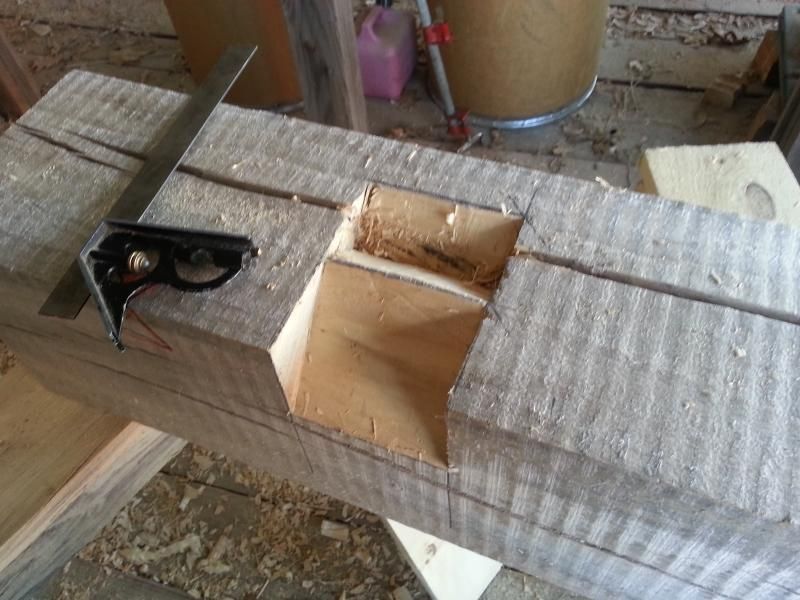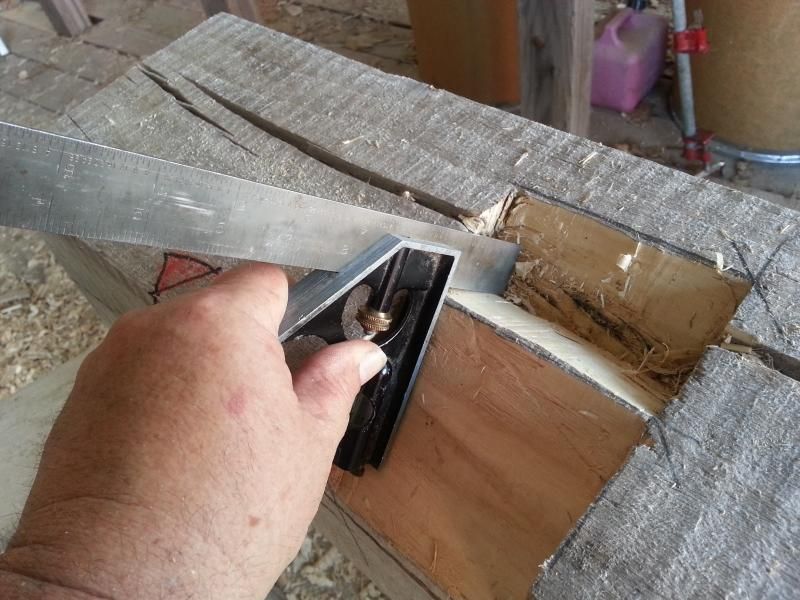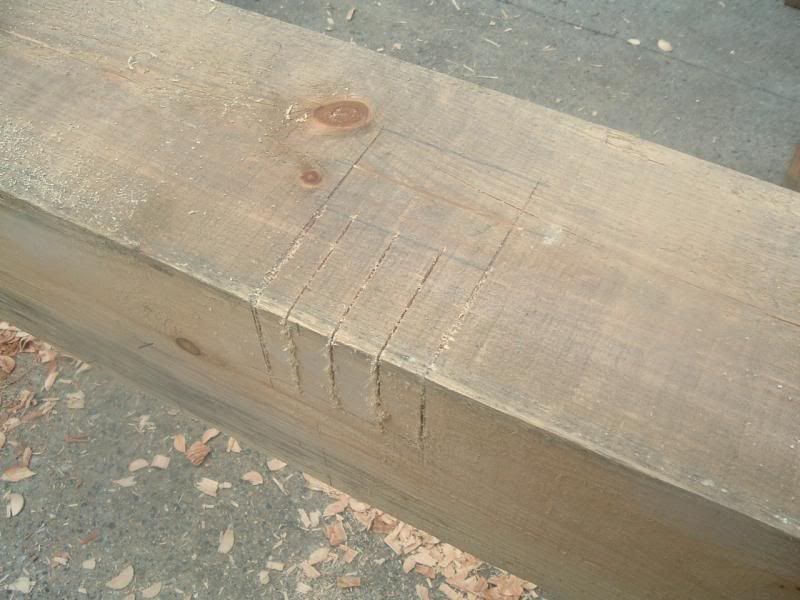|
 Re: Cutting Step Lap Rafter Seat
[Re: ATC]
#32306
05/29/14 12:58 AM Re: Cutting Step Lap Rafter Seat
[Re: ATC]
#32306
05/29/14 12:58 AM
|
Joined: Feb 2006
Posts: 718
Dave Shepard

Member
|

Member
Joined: Feb 2006
Posts: 718 |
I like step laps. They aren't too bad to cut when you've done a few. I don't know if code would require a clip or not. The last building I did I used a 6" HeadLok on each rafter.
Member, Timber Framers Guild
|
|
|
 Re: Cutting Step Lap Rafter Seat
[Re: ATC]
#32307
05/29/14 03:07 PM Re: Cutting Step Lap Rafter Seat
[Re: ATC]
#32307
05/29/14 03:07 PM
|
Joined: Nov 2003
Posts: 687
Gabel

Member
|

Member
Joined: Nov 2003
Posts: 687 |
There are a handful of framers who use it still, but it is pretty much not used in the timber frame industry. Yeah, I was talking to a Timber-Framer buddy a while back, and he was saying that no one makes those anymore. They just cut a standard birds-mouth, and run a TimberLok down through the top plate.  I'm trying to go a bit more traditional. I know there are other rafter-to-top plate joints, but I don't know of any that allow you to continue the rafter for the rafter tail. As far as wind loading, when I go to build a house, I'll have it engineered. I don't know if a wood peg would suffice, or if you'd be required to use a Simpson type hurricane tie. Anyone else have experience with that? No worries -- if you have the time and the will then go for it. Like I said, step laps are good joints. I hope it doesn't sound like I'm trying to pick a fight or talk you out of something -- I'm not. As a timber frame business owner and our company's designer, I'm constantly making decisions like birdsmouth over step lap. Which is better? Which is faster (cheaper)? How much better/faster? Is the extra 5,10,30,60 man hours in the frame worth it to the customer? Will they pay it? Should they have to? How much better will their home or barn be if we use this joint over that one? Riven pegs over sawn or turned? These are tough questions to answer decisively. They are complicated by the financial dimension to the calculus. We each get to decide our perspective on this - what we value -- and use that to decide where the line is between cutting a corner and being efficient. That line isn't in the same place for everyone and I like that -- it keeps me thinking about it. Enough philosophy- As for uplift, you probably won't need a simpson tie -- but a wood peg may not do it. I've seen square pegs used in old barns to try to add withdrawal resistance. A headed structural timber screw like Dave mentioned has always worked for us and may be a good compromise. We've never had to put hurricane clips on any common rafter in up to 130 MPH wind zones. But YMMV depending on your engineer and the details of the frame and enclosure.
Last edited by Gabel; 05/29/14 03:07 PM.
|
|
|
 Re: Cutting Step Lap Rafter Seat
[Re: ATC]
#32308
05/29/14 08:08 PM Re: Cutting Step Lap Rafter Seat
[Re: ATC]
#32308
05/29/14 08:08 PM
|
Joined: Nov 2005
Posts: 305
timberwrestler

Member
|

Member
Joined: Nov 2005
Posts: 305 |
I do them a bunch (or my guys do them now), but as Gabel mentioned there's definitely some time in them.
Around here, you see them a lot, with a square peg in a round hole (traditionally). A structural screw is the modern alternative, and is easy, cheap, and makes everyone happy. There's even a code-approved alternative to hurricane clips for stick rafters from Fastenmaster--a Timberlok up from the bottom side of the plate into the rafter.
As far as cutting them goes, it's a lot easier to describe in a demonstration, but...figure the lines for the step and the lap, either with math, or a framing square. Saw and chisel the lap part, trying not to undercut it. Stand on the inside of the plate, hold the chisel vertically (not straight up and down, just the opposite of horizontally), tilt it to the roof pitch by aligning the top edge of the chisel with the lap below. That scores the end grain of the step. Repeat on the other side of the step, chisel the waste out in the middle. Keep doing that and then start checking for square and depth with a combo square off of the lap. I don't know if that makes sense, but that's the quick description.
|
|
|
 Re: Cutting Step Lap Rafter Seat
[Re: ATC]
#32312
05/30/14 01:29 PM Re: Cutting Step Lap Rafter Seat
[Re: ATC]
#32312
05/30/14 01:29 PM
|
Joined: Mar 2002
Posts: 1,687
Jim Rogers

Member
|

Member
Joined: Mar 2002
Posts: 1,687 |
This is a sample one I just made the other day at a workshop in Nebraska:  4" wide and 12/12 roof pitch. Here is how I check my work:  Hope that helps. Jim Rogers
Whatever you do, have fun doing it!
|
|
|
 Re: Cutting Step Lap Rafter Seat
[Re: ATC]
#32313
05/30/14 01:36 PM Re: Cutting Step Lap Rafter Seat
[Re: ATC]
#32313
05/30/14 01:36 PM
|
Joined: Mar 2002
Posts: 1,687
Jim Rogers

Member
|

Member
Joined: Mar 2002
Posts: 1,687 |
When we cut these for a project in Atlanta we used a small trim saw to cut the center line of the step to allow the wood to be removed:  As well as cutting relief cuts for the lap section. Jim Rogers
Whatever you do, have fun doing it!
|
|
|
 Re: Cutting Step Lap Rafter Seat
[Re: Gabel]
#32315
05/30/14 04:37 PM Re: Cutting Step Lap Rafter Seat
[Re: Gabel]
#32315
05/30/14 04:37 PM
|
Joined: Jul 2012
Posts: 15
ATC
 OP
OP
Member
|
OP

Member
Joined: Jul 2012
Posts: 15 |
I hope it doesn't sound like I'm trying to pick a fight or talk you out of something -- I'm not. As a timber frame business owner and our company's designer, I'm constantly making decisions like birdsmouth over step lap. Which is better? Which is faster (cheaper)? How much better/faster? Is the extra 5,10,30,60 man hours in the frame worth it to the customer? Will they pay it? Should they have to? How much better will their home or barn be if we use this joint over that one? Riven pegs over sawn or turned? These are tough questions to answer decisively. They are complicated by the financial dimension to the calculus. We each get to decide our perspective on this - what we value -- and use that to decide where the line is between cutting a corner and being efficient. That line isn't in the same place for everyone and I like that -- it keeps me thinking about it.
Enough philosophy-
As for uplift, you probably won't need a simpson tie -- but a wood peg may not do it. I've seen square pegs used in old barns to try to add withdrawal resistance. A headed structural timber screw like Dave mentioned has always worked for us and may be a good compromise. We've never had to put hurricane clips on any common rafter in up to 130 MPH wind zones. But YMMV depending on your engineer and the details of the frame and enclosure. I didn't take it that way at all. One of my favorite past-times is philosophizing about construction. I appreciate all the help I've gotten. I'll just keep practicing on that joint.
|
|
|
 Re: Cutting Step Lap Rafter Seat
[Re: ATC]
#32317
05/30/14 04:41 PM Re: Cutting Step Lap Rafter Seat
[Re: ATC]
#32317
05/30/14 04:41 PM
|
Joined: Jul 2012
Posts: 15
ATC
 OP
OP
Member
|
OP

Member
Joined: Jul 2012
Posts: 15 |
Jim, Thanks for the pics. Are those substantially more difficult if the pitch is other than 12/12?
Also, where do you do workshops? Have you ever done one in Northern California?
|
|
|
 Re: Cutting Step Lap Rafter Seat
[Re: ATC]
#32318
05/30/14 07:48 PM Re: Cutting Step Lap Rafter Seat
[Re: ATC]
#32318
05/30/14 07:48 PM
|
Joined: Feb 2006
Posts: 718
Dave Shepard

Member
|

Member
Joined: Feb 2006
Posts: 718 |
Jack Sobon mentions in his first book that the joint works well down to an 8/12 roof. I used it on a couple of 6/12 roofs, and you have to invade the inside arris of the plate. I don't think it is any different to cut at the lower pitches. For the record, one 6/12 roof was a shed off of a 12'x16' Dutch house. That looked good. They other is an 8'x8' shed. I think the roof looks too flat.
Member, Timber Framers Guild
|
|
|
 Re: Cutting Step Lap Rafter Seat
[Re: ATC]
#32320
05/30/14 09:09 PM Re: Cutting Step Lap Rafter Seat
[Re: ATC]
#32320
05/30/14 09:09 PM
|
Joined: Dec 2007
Posts: 1,882
TIMBEAL

Member
|

Member
Joined: Dec 2007
Posts: 1,882 |
Dave, just cut a 16" wide plate. 
|
|
|
 Re: Cutting Step Lap Rafter Seat
[Re: ATC]
#32321
05/31/14 12:23 PM Re: Cutting Step Lap Rafter Seat
[Re: ATC]
#32321
05/31/14 12:23 PM
|
Joined: May 2002
Posts: 447
Will Truax

Member
|

Member
Joined: May 2002
Posts: 447 |
Though I'm here in the heart of historical Common Purlin land, I've cut plenty of these over the years (one even right on the coast - Pancake head structural screws) and have always seen the advantage being the self defining geometry - (as opposed to simple bird's mouths) When the step goes home the whole of the rafter is where it belongs.
And I've never seen them as all that hard to cut, (85% of the waste in both the step and the lap is best removed with an ax) even when controlling and truing the geometry with datum based layout - Yes you can place these precisely in even the wonkiest full length plates.
|
|
|
|
|